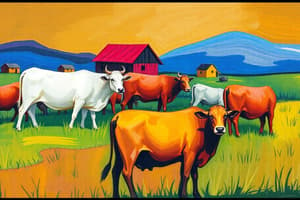Podcast
Questions and Answers
Which sustainable agriculture practice involves planting alternating strips of different crops or cover plants?
Which sustainable agriculture practice involves planting alternating strips of different crops or cover plants?
- Intercropping
- Strip cropping (correct)
- Agroforestry
- Contour farming
What is the primary reason for areas with sandy soils producing more rice?
What is the primary reason for areas with sandy soils producing more rice?
- Sandy soils have weather patterns that favor rice growth.
- Sandy soils have better water retention capacities suited for rice.
- Sandy soils are rich in nutrients ideal for rice cultivation.
- Sandy soils are less prone to soil erosion, benefiting rice crops. (correct)
How does agroforestry contribute to farmland improvement in rural north India?
How does agroforestry contribute to farmland improvement in rural north India?
- By reducing soil fertility.
- By integrating trees and shrubs to improve soil fertility and reduce erosion. (correct)
- By increasing the risk of soil erosion.
- By promoting mono-cropping practices.
In what way can warmer temperatures due to climate change affect crop yields?
In what way can warmer temperatures due to climate change affect crop yields?
What is a key strategy adopted by farmers in response to the impact of climate change on agriculture?
What is a key strategy adopted by farmers in response to the impact of climate change on agriculture?
What is a major challenge faced by farming in rural northern India?
What is a major challenge faced by farming in rural northern India?
How does contour farming help in sustainable agriculture practices in rural north India?
How does contour farming help in sustainable agriculture practices in rural north India?
Which irrigation method helps in conserving water while ensuring crops receive adequate hydration?
Which irrigation method helps in conserving water while ensuring crops receive adequate hydration?
What is a consequence of excessive extraction of groundwater for agricultural purposes?
What is a consequence of excessive extraction of groundwater for agricultural purposes?
How do farmers in rural north India combat the groundwater crisis?
How do farmers in rural north India combat the groundwater crisis?
Which practice helps in sustainable agriculture in rural northern India?
Which practice helps in sustainable agriculture in rural northern India?
What is a common method used for supplying water to crops when irrigation methods are not available?
What is a common method used for supplying water to crops when irrigation methods are not available?
Flashcards are hidden until you start studying
Study Notes
Farming in Rural Northern India: Groundwater Crisis, Irrigation Methods, Crop Cultivation, Sustainable Agriculture Practices, Impact of Climate Change
Farming is a vital aspect of life in rural northern India, where it plays a significant role in the economy and food security. However, this sector faces numerous challenges, including a severe groundwater crisis, various irrigation methods, diverse crop cultivation, efforts towards sustainable agriculture practices, and the looming threat of climate change's impacts on agriculture.
Groundwater Crisis
India relies heavily on groundwater sources for agricultural purposes. Unfortunately, overuse and depletion have led to a critical situation where water tables are falling rapidly in many regions. This excessive extraction has been attributed to the expansion of the green revolution in drier environments and increased demand from industry. As a result, there's growing concern among policymakers about the sustainability of India's farming system.
Irrigation Methods
In order to address the groundwater crisis, farmers in rural north India employ different irrigation methods such as sprinklers, drip lines, and surface pond systems. These methods help conserve water while ensuring that crops receive adequate hydration. Additionally, some areas utilize flood irrigation, which involves flooding fields with water to nourish the plants. Other areas rely on rainfed farming if they don't have other means of supplying water to their crops.
Crop Cultivation
The region is known for its diverse range of crops, each suited to specific environmental conditions. Some common crops grown here include wheat, rice, sugarcane, cotton, and fruits like mangoes and bananas. The choice of crops depends on factors such as soil type, weather patterns, and market demands. For instance, areas with sandy soils tend to produce more rice due to their suitability for this crop.
Sustainable Agriculture Practices
Despite facing challenges, farmers in rural north India actively engage in sustainable agriculture practices to ensure long-term productivity and resource conservation. These include contour farming, strip cropping, intercropping, and agroforestry. Contour farming helps prevent soil erosion by following the natural shape of the land, while strip cropping involves planting alternating strips of different crops or cover plants. Intercropping refers to growing two or more crops together in the same field, maximizing land use and reducing pests. Agroforestry combines farming and forestry, integrating trees and shrubs into farmland to improve soil fertility and reduce the risk of erosion.
Impact of Climate Change on Agriculture
Climate change poses a significant threat to the agricultural sector in rural northern India, particularly through changes in temperature and precipitation patterns. Warmer temperatures can lead to earlier plant maturation, reduced yields, and even crop failures, while altered precipitation patterns may cause droughts and floods. In response, farmers are experimenting with new varieties of seeds adapted to these changing conditions. They are also implementing better irrigation techniques and improving the efficiency of agricultural machinery to cope with the effects of climate change.
In conclusion, farming in rural northern India is a complex and dynamic landscape shaped by a mix of traditional and modern practices. While it faces significant challenges related to groundwater depletion and the impact of climate change, innovative solutions and resilient farmers continue to adapt, enabling this essential sector to thrive despite adversity.
Studying That Suits You
Use AI to generate personalized quizzes and flashcards to suit your learning preferences.




